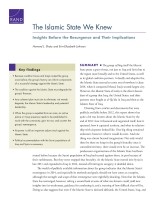| 来源类型 | Research Reports
|
| 规范类型 | 报告
|
| ISBN | 9780833091864
|
| 来源ID | RR-1267-OSD
|
| The Islamic State We Knew: Insights Before the Resurgence and Their Implications |
| Howard J. Shatz; Erin-Elizabeth Johnson
|
| 发表日期 | 2015
|
| 出版年 | 2015
|
| 页码 | 24
|
| 语种 | 英语
|
| 结论 |
By the End of 2011, Much Was Known About How the Islamic State Financed and Organized Itself, Established Control, and Responded to Airpower- The group's financial strategy hinged on raising money locally rather than focusing on donations. The group exhibited sophisticated financial management and reallocated money among different units.
- The group was (and is) bureaucratic and hierarchical. This created a bench of personnel knowledgeable about managing a terrorist group that intended to become a state.
- The group's approach to establishing territorial control began with infiltration and ended in conquest. Clandestine assassination and intimidation campaigns have been in the group's playbook for more than a decade.
- Airpower proved to be an effective tool against the group and something that it feared. Airpower was used to target leaders, was employed in combined arms operations, and was instrumental in transporting U.S. personnel to conduct operations against specific targets.
The Islamic State of Today Is a Direct Descendant of Its Predecessors- The group now has the declaration of a global caliphate, a greater scale of territory and personnel, and growth outside Iraq and Syria.
- Because Iraqis and coalition forces routed the group once, the group's history can inform components of a successful strategy against the Islamic State.
History Can Provide Warning Indicators- The group has thrived where there are deep social cleavages and ineffective government.
- But the group also created ineffective government through assassination campaigns.
- Observing a pattern of intimidation and assassinations against established government authorities can provide a first indicator of trouble.
|
| 摘要 |
- The coalition against the Islamic State must degrade the group's finances.
- Any coherent plan against the Islamic State must aim to eliminate its leadership and potential leadership.
- A better hold strategy once the Islamic state is pushed out of an area is essential. After such a defeat, an active police or troop presence needs to be established to work with the community, gain its trust, and counter the group's reemergence.
- Airpower is still an important adjunct tool against the Islamic State.
- To defeat the Islamic State, political accommodation with the Sunni populations of Iraq and Syria is necessary.
|
| 主题 | Al Qaida
; Counterterrorism
; Iraq
; The Islamic State (Terrorist Organization)
; Syria
; Terrorism Financing
|
| URL | https://www.rand.org/pubs/research_reports/RR1267.html
|
| 来源智库 | RAND Corporation (United States)
|
| 资源类型 | 智库出版物
|
| 条目标识符 | http://119.78.100.153/handle/2XGU8XDN/107946
|
推荐引用方式
GB/T 7714 |
Howard J. Shatz,Erin-Elizabeth Johnson. The Islamic State We Knew: Insights Before the Resurgence and Their Implications. 2015.
|
|
文件名:
|
x1495316196858.jpg
|
|
格式:
|
JPEG
|

|
文件名:
|
RAND_RR1267.pdf
|
|
格式:
|
Adobe PDF
|
除非特别说明,本系统中所有内容都受版权保护,并保留所有权利。